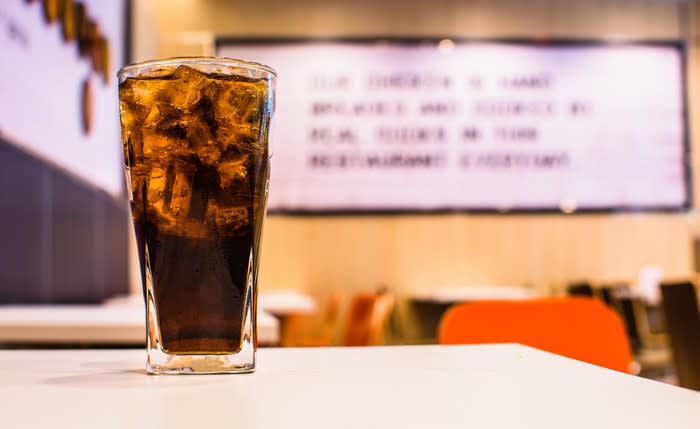Where Will PepsiCo Be in 5 Years?
PepsiCo (NASDAQ: PEP) has been a reliable stock for turbulent times. Its portfolio of products is well diversified across the beverage and packaged food markets, it consistently repurchases its shares, and it has raised its dividend annually for over four decades.
That's why PepsiCo's stock rallied nearly 50% over the past five years as the S&P 500 rose 45%. But can PepsiCo continue climbing as the U.S.-China trade war, tariffs, interest rates, and other macro issues cause investors to flee to safer assets like bonds?
Let's glance into what could be the company's next five years to find out.

Image source: Getty Images.
The past five years
To understand where PepsiCo is headed, we should look back at its organic revenue and core EPS growth (which exclude acquisitions, divestments, currency impacts, and other one-time losses and benefits) over the past five years.
YOY growth | 2014 | 2015 | 2016 | 2017 | 2018 |
|---|---|---|---|---|---|
Organic revenue | 4% | 5% | 4% | 2% | 4% |
Core EPS* | 9% | 10% | 9% | 9% | 9% |
Source: PepsiCo annual reports. YOY = year-over-year. *Constant currency basis.
PepsiCo's revenue growth remained rock solid even as soda consumption rates fell in most developed countries. Like Coca-Cola (NYSE: KO), PepsiCo diversified its soda lineup with zero-calorie and sugar-free options and expanded its beverage portfolio with noncarbonated drinks like juices and teas. PepsiCo also launched healthier products at its Frito-Lay and Quaker Foods units to keep up with shifting consumer tastes.
The next five years
PepsiCo expects its organic revenue to rise 4% this year, but its core EPS to dip 1% on a constant currency basis. It attributes that decline to a tough comparison to 2018, when asset sales, refranchising efforts, and a lower tax rate boosted its EPS. By comparison, Coca-Cola expects its organic revenue to rise 4% this year, and for its adjusted EPS to stay roughly flat.
Analysts expect PepsiCo's annual earnings to grow at an average rate of 4% over the next five years, indicating that year-over-year comparisons should normalize after this year. Coca-Cola is expected to grow its earnings by 5% annually during the same period.
PepsiCo plans to return about $8 billion to shareholders this year via $5 billion in dividends and $3 billion in share buybacks. That's significantly higher than its projected free cash flow of $5 billion -- but it indicates that PepsiCo isn't shy about dipping into its cash reserves to reward long-term investors. That trend should continue over the next five years, which will tighten up its valuations and lock in more income investors.

Image source: Getty Images.
The main headwinds
However, several long-term headwinds could still throttle PepsiCo's growth. Soda consumption in the U.S. is currently at a three-decade low, according to Beverage Digest, and that softer demand is reflected across other markets. The approval of soda taxes in several markets could exacerbate that pain.
PepsiCo could face tougher competition from Coca-Cola, which has been expanding its portfolio with new versions of Coca-Cola, energy drinks, coffee, and even alcoholic beverages.
PepsiCo's Frito-Lay and Quaker Foods units also face rising competition from healthier brands and private-label brands from retailers like Costco -- which are already causing big headaches for packaged food leaders like Kraft Heinz and General Mills.
Former PepsiCo CEO Indra Nooyi, who led the company from 2006 to 2018, focused heavily on developing healthier products for Frito-Lay and Quaker Foods. It's unclear if her successor, Ramon Laguarta, will stick to that plan over the next few years. If he doesn't, PepsiCo's packaged foods business could suffer the same fate as its peers.
Lastly, only 64% of PepsiCo's revenue came from North America in the first half of 2019. Its overseas businesses leave it heavily exposed to a strong dollar, weakening local currencies (especially in Latin America), and ongoing geopolitical problems and macroeconomic headwinds.
So where will PepsiCo be in five years?
PepsiCo will face myriad challenges over the next five years, but the strength of its core brands, its deep portfolio of secondary brands, and its shareholder-friendly strategies should lift the stock higher. PepsiCo should also remain a solid defensive stock in a recession -- which seems more and more likely to hit within the next five years.
More From The Motley Fool
Leo Sun has no position in any of the stocks mentioned. The Motley Fool has the following options: short January 2020 $180 calls on Costco Wholesale and long January 2020 $115 calls on Costco Wholesale. The Motley Fool recommends Costco Wholesale. The Motley Fool has a disclosure policy.
This article was originally published on Fool.com

 Yahoo Finance
Yahoo Finance 